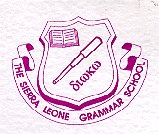CMS Grammar School, Freetown
| Sierra Leone Grammar School | |
|---|---|
 |
|
| Location | |
|
Freetown Sierra Leone |
|
| Coordinates | 8°29′38″N 13°16′02″W / 8.493829°N 13.2673°WCoordinates: 8°29′38″N 13°16′02″W / 8.493829°N 13.2673°W |
| Information | |
| School type | Secondary |
| Motto | Διωκω (Greek: Dioko) (To Pursue) |
| Established | 25 March 1845 |
| Principal | Akinwande J. Lasite |
The Sierra Leone Grammar School was founded on 25 March 1845 in Freetown, Sierra Leone, by the Church Mission Society (CMS), and at first was called the CMS Grammar School. It was the first secondary educational institution for West Africans with a European curriculum. Many of the administrators and professionals of British West Africa were educated at the school.
The Church Mission Society founded Fourah Bay College in 1827 to provide training for African missionaries. As the academic standards of the college rose, the regular schools in the region were unable to produce students with sufficient education to be admitted to the college. The grammar school was founded to fill the gap. The CMS obtained a lease on a massive building with arches on all sides at Regent Square, Freetown, that until recently had been the house of the Governor. Opening on 25 March 1845, the CMS Grammar School was the first secondary education institution in Sierra Leone and the first in sub-Saharan Africa for Africans.
The CMS Grammar School offered a western-style curriculum that included Greek, Latin, Astronomy and Music. Other subjects were English, French, Bible Knowledge, Mathematics, Science, Geography, History, Recitation and Physical Education. The school began with 14 pupils from Fourah Bay College. At first the main purpose was to train people who would go on to become missionaries, so all pupils were expected to convert to Christianity.
Six months after the school's foundation the number of pupils had risen to 30. Within a year, three of the pupils were able to read the New Testament in Greek and understood Euclid's Elements. They were sent on to Fourah Bay College. By 1847 the school had 45 pupils, of whom 18 were fee paying. The school developed a reputation for excellence of education and for the value of subsequent career prospects. The availability of boarding facilities at Regents Square made it practical for pupils to come from throughout the colony and from elsewhere in Africa. Many prominent West Africans were educated there.
The school soon expanded into training teachers, resulting in a great improvement in local standards of primary school education. It also began to provide general education for the emerging middle class in the Gambia, Gold Coast and Nigeria in addition to its original role of preparing students for entry to Fourah Bay College. Some students were subsidized by the CMS, but most paid fees. By 1850 the only contribution required of the CMS was the salary of the European principal. The CMS Grammar School in Lagos, Nigeria was founded in June 1859. It was modeled on the Freetown school, which by then had earned a high reputation. As the Freetown school grew and prospered, it was divided into a Preparatory and Upper school. As early as 1865 some of the more promising students were being sent to England for further training.
...
Wikipedia
